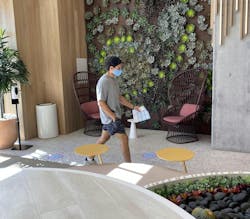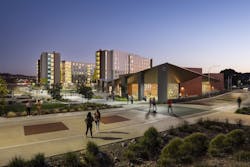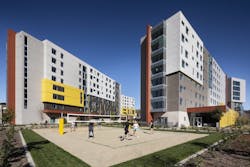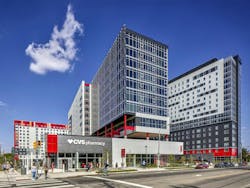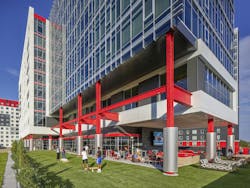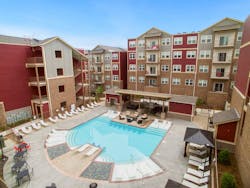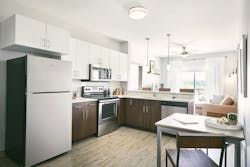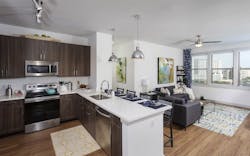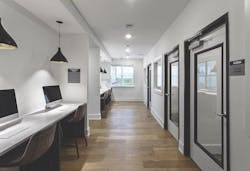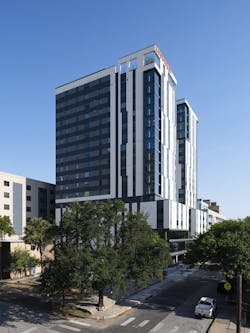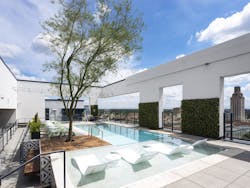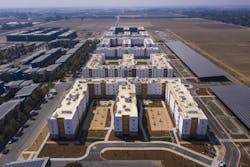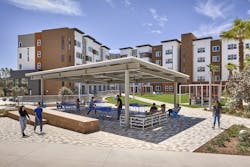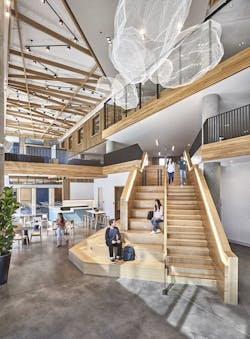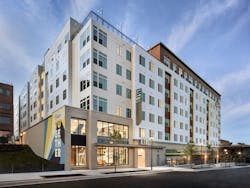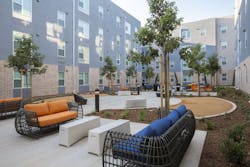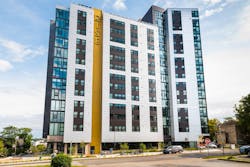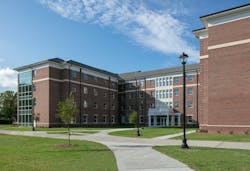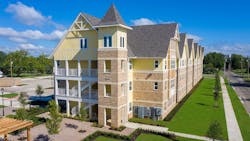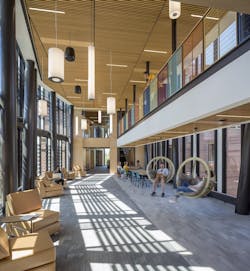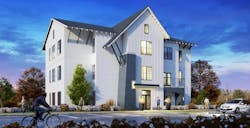As the coronavirus pandemic grabbed hold last spring, the student housing design and construction industry, like so much of the country’s economic sectors, faced gnawing uncertainties. Would universities open in the fall? Would students be allowed to return to campus? Or would all learning be done remotely? If so, would college residence construction be put on hold? For months, no one had definitive answers to these questions.
In July, ahead of the scheduled opening of most classes for the fall semester, I interviewed Mitch Dalton, Chief Director of Design at Core Spaces, for our new streaming service “The Weekly” about his company’s survey of 2,500 of its tenants—students who live in Core Spaces’ off-campus housing. Ninety percent of them said they wanted to come back to campus. Almost three-quarters (73%) said they would return to their off-campus apartments even if their institutions offered only online instruction.
Most of the students (60%) said they were dissatisfied with remote learning. Understandably, they missed the classroom give-and-take with their professors and fellow students. Isn’t that what “the college experience” is all about? Even so, four in five (80%) said they would rather study remotely in their college apartments than at home. As we’ve all learned, “work from home” is not the unadulterated blessing it was made out to be, pre-Covid.
In the fall, as the nation’s more than 4,000 colleges and universities struggled with whether to open for in-person instruction, go fully remote, or try some sort of hybrid scheme, construction—deemed an essential business—continued apace on student housing projects across the country. Here are 14 of the newest student residences on or near America’s college campuses.
1. OLIV TUCSON | TUCSON, ARIZ.
Student housing developer Core Spaces teamed up with The Marshall Foundation, Up Campus, and developer Tom Warne to create ōLiv Tucson, a luxury 243-unit, 14-story mixed-use residence abutting the University of Arizona. It is the final piece of the Main Gate Square redevelopment, totaling 1,632,200 sf. The development team partnered with AJ Capital Partners, parent company of Graduate Hotels, on the Graduate Tucson, featuring 164 guestrooms, a ground-floor lobby and café, a rooftop swimming pool and bar with panoramic mountain views, a fitness center, and meeting and event space. The 605-bed ōLiv Tucson is served by two Sun Link streetcar stations. Antunovich Associates (architect), Studio K (interior designer), and Katerra (GC) formed the project team for ōLiv Tucson. IMAGE: COURTESY CORE SPACES
IMAGE: COURTESY CORE SPACES
2. HOUSING AND DINING COMMONS | California State Polytechnic University–Pomona
Cal Poly Pomona’s Housing and Dining Commons won a National Award of Merit from the Design-Build Institute of America. The design-build team of HMC Architects (executive architect, housing design architect), EYRC Architects (dining commons architect), and Sundt Construction (GC) created intimate environments. The two mid-rise student housing buildings interlace shared social spaces, natural light, and open-air connections throughout the eight floors of each structure. Each floor has two 35-student households. The dining facility seats 650.
Indoor-outdoor connections are a defining feature of the Cal Poly Pomona dual residence towers. Ground-floor amenities are connected to outdoor spaces. PHOTOS: LAWRENCE ANDERSON PHOTOGRAPHY
3. VANTAGE | Philadelphia, Pa.
This Goldenberg Group commissioned Niles Bolton Associates to design this 471,000-sf mixed-use development adjacent to Temple University in North Philadelphia for 984 students. The 19-story Vantage offers 28,570 sf of amenity space, 32,331 sf of retail anchored by a CVS pharmacy, and a 5,000-sf study lounge. The 12,62-sf fitness center provides space for stretching, cardio, high-intensity interval training, circuit, strength training, power lifting, and active recovery.
The 368-unit Vantage provides studio and 1- to 5-bedroom configurations for 984 students near Temple University. Niles Bolton Associates (architect, space planning/interior architecture, landscape designer) led the project team for The Goldenberg Group: RD Jones (interior design), The Harman Group (SE), Bohler Engineering (CE), Bala Consulting Engineers (MEP), InfiniSys (low-voltage design), Hillis-Carnes (waterproofing consultant), and INTECH Construction (GC). PHOTOS: © HALKIN MASON PHOTOGRAPHY
4. THE AVENUE | Fayetteville, Ark.
Located just minutes from the University of Arkansas campus, The Avenue offers 180 fully furnished two- and four-bedroom apartments with private bedrooms (652 total) and bathrooms, fully equipped kitchens, in-unit washer/dryers, 55-inch smart HDTVs, 2GB internet wired and wireless service, and a resort-style pool. Students can control common area smart lighting, smart thermostats, and smart ceiling fans through an integrated system anchored by an Amazon Echo Dot. Kitchen & Associates was the architect and Southern Building Group the contractor for Haven Campus Communities. PHOTO: RMA SERVICES HTTP://RMASERVICES.ORG/
A typical kitchen space at The Avenue. Amenities include study pods, a grab-and-go snack shop, and a 10,400-sf clubhouse. Haven Campus Communities (developer) provided a fitness center, a pavilion with multiple HDTVs, built-in grilling stations, a tanning room, private study rooms, a computer center, a cyber-lounge, and a Starbucks. PHOTO: RMA SERVICES HTTP://RMASERVICES.ORG/
5. THE HUDSON | College Station, Texas
BSB Design led the project team for developer Stillwater Capital Investment on The Hudson, a 391-bed, eight-story infill property in College Station’s Northgate entertainment district, near Texas A&M University. The entire structural steel building skeleton was custom fabricated at Prescient’s factory in Arvada, Colo., and shipped to the job site. “The building footprint evolved based on the module requirements for the steel system,” said BSB Design’s Deena Roumeliotis, AIA, LEED AP, the project architect. “This meant all framing had to maintain a consistent center line, so as we manipulated the unit plans and bearing walls, we created a number of alcoves and niches in the structure.”
Private study rooms at The Hudson, near the Texas A&M University campus. Project team: BSB Design (architect), Hue Design (interior designer), Horton Design Group (SE), Johnson & Pace (CE), Jordan & Skala Engineers (MEP), ViZ Design and Andrew Morris Landscape Architecture (landscape designers), and Stillwater GC (general contractor). PHOTOS: JACOB SHARP PHOTO
6. MOONTOWER | Austin, Texas
JE Dunn was the design-builder and Gensler the architect for this 166-unit, 567-bed private student housing project one block from the West Campus of the University of Texas at Austin. Developer Lincoln Ventures’ Moontower is a 376,521 sf, 18-story student housing tower with 191 underground parking spots. Amenities include a rooftop pool, a fitness center with yoga room and spin studio, a coffee bar, and group study rooms.
The 18th-floor pool deck at Moontower offers views of the UT tower, the Longhorns football stadium, and downtown Austin. JE Dunn Construction (GC) led the design-build team of Gensler (architect), Chelsea Kloss (interior design), Datum (SE), Wuest Group (CE), Jordan & Skala Engineers (MEP), Kilgore Mechanical (mechanical engineer), FSG Electric (electrical engineer), and TBG (landscaping). PHOTOS: BRIAN MIHEALSICK PHOTOGRAPHY
7. THE GREEN AT WEST VILLAGE – PHASE 1 | University of California, Davis
The Green at West Village at University of California, Davis, the largest student housing project in the U.S., will be a zero-net energy community using on-site solar. Extensive solar arrays surround the net-zero energy University of California, Davis, mega-project. In Phase I, the project team, led by Stantec, delivered the first three residential buildings (1,005 beds), a utility building, and outdoor courtyards. Once completed, the project will be comprised of nine four-story apartment buildings (total 3,300 beds), community spaces, and recreation fields across 34 acres. The project, for developer The Michaels Organization, is targeting LEED Silver certification. Stantec provided architecture, interior design, MEP engineering, building acoustics, lighting design, environmental services, IT technology, specifications, and construction administration.
The Stantec-led project team: KPFF (SE), Sandis (CE), Mid Pacific Engineering (geotechnical), Frontier Engineering (sustainability, energy modeling), Cummings (cost estimating), Endelman & Associates (life safety assessment), Jensen Hughes (life safety/FP), Prescient (metal framing system), Sun Power (PV panels), and CBG Building Group (GC). PHOTO: JOHNNY STEVENS
8. PLAZA VERDE | UNIVERSITY OF CALIFORNIA, IRVINE
The 652-unit net-zero-energy Plaza Verde residence hall won a 2020 Gold Nugget Award for developer American Campus Communities. The 2,351-bed complex uses an all-electric system to eliminate the need for natural gas. PV arrays add to the building’s energy efficiency. Two residential buildings surround a central parking structure and bike storage facility (“The Hub”). To accommodate the 13.3-acre site’s 20-foot vertical grade change, the buildings were stepped up and landscaped terraces were created. The development team: KTGY Architecture + Planning (architect), CRA (interior design), DCSE (SE), Hunsaker (CE), TAD (mechanical/plumbing), Candela (electrical), Cadmus (sustainability), IMA (landscape), and Morley Benchmark (GC).
At Plaza Verde, on the campus of the University of California, Irvine, eco-friendly building materials were used to limit the negative impact associated with raw material extraction and transportation. All wood was either nontropical, reclaimed, or sustainably harvested. UCI has set a goal of carbon neutrality by 2025. PHOTOS: CREATIVE NOODLE
9. ALTUS | TOWSON UNIVERSITY, MD.
This 720-bed student residence near the Towson University campus, 10 miles north of Baltimore, is one of four Gilbane Development Company has completed this year, delivering over 3,000 beds for students at Towson, Arizona State, Oregon State, and Kennesaw State universities. Altus is part of Towson Row, a $350 million, 1 million-sf mixed-use development of retail, hotel, residential, and office space. Amenities include a clubroom, fitness center, computer lounge, study rooms, game room, swimming pool, bocce court, and pet park. Video tour: https://vimeo.com/365144623.
The 214 apartment units at Altus, near the campus of Towson (Md.) University, come fully furnished with private baths, wood-style flooring, and washer/dryer units. Assisting Gilbane Development: Design Collective Inc. (architect), Bohler Engineering (MEP), and Bozzuto (GC). PHOTO: DARRIS LEE HARRIS
10. THE HARBOUR | Orange Coast College
The 25,000-student Orange Coast College, Costa Mesa, recently became the first community college in Southern California to provide on-campus housing. The Harbour, a $123 million complex, was financed under a public-private partnership. Servitas (developer) completed the project despite a strike by union glaziers. Apartments in the four-story wood frame building are furnished with a full kitchen, living room, bathroom, sofa, TV stand, and coffee table.
The 823-bed residence center has study lounges on each floor, package lockers, bike storage, on-site laundry, resident-only parking, and controlled building access with safety camera surveillance. Developer Servitas’s team for Coastal Community College District: Brailsford & Dunlavey (PM), HPI Architecture (architect), MVE Architects (designer), Design West Engineering, The Scion Group (management), and Moss & Associates (GC). PHOTO: MINDY MELLENBRUCH PHOTOGRAPHY
11. RISE ON CHAUNCEY | WEST LAFAYETTE, IND.
For Rise on Chauncey, CA Ventures’ student housing facility near the Purdue University campus, Brinkmann Constructors (GC) completely redesigned the building’s foundation and earth retention systems. The project had three levels below grade, which would have required an earth retention system to excavate and a perimeter cast-in-place concrete basement wall. Brinkmann came up with a scheme to accomplish both tasks with a single system, eliminating 22,000 sf of concrete walls and saving the developer $2.5 million. Other team members: Shepley Bulfinch (architect), Pierce Engineers (SE), TBIRD Design Services (CE), and Wiegmann Associates (HVAC).
At sixteen stories, Rise on Chauncey is the tallest building in West Lafayette, Ind. The 458,000-sf structure has 283 fully furnished luxury apartments, from studios to four-bedroom units, totaling 675 beds. PHOTO: MATTHEW CORSARO, LCP360 PHOTOGRAPHY
12. STUDENT HOUSING VILLAGE | University of North Carolina Wilmington
Balfour Beatty (GC) and Clark Nexsen (architect, MEP) designed and built the UNCW Student Housing Village for first- and second-year students via a public-private partnership with the nonprofit Collegiate Housing Foundation. The two buildings in phase one supplied 1,034 of the 1,814 beds that will complete the planned grand quadrangle over the next three years—all part of a major capital building program to buttress enrollment. The new housing features traditional pod-style rooms and semi-suites, common areas, meeting space, classrooms, and a student success center. McKim and Creed did the civil engineering and landscape design.
Student Housing Village is part of Balfour Beatty’s four-building, $200 million contract with the University of North Carolina Wilmington, which includes the renovation of a building damaged by a hurricane in 2018. PHOTO: JIM SINK PHOTOGRAPHY
13. NORTH FLATS | Austin College
KWA Construction (GC) delivered 38 units of on-campus student housing for Austin College, a liberal arts institution in Sherman, Texas, 65 miles north of Dallas. The three-story. 43,613-sf North Flats property offers 133 beds in one- to four-bedroom residences with full kitchens, washer/dryer combos, living areas, and built-in workstations.
North Flats was executed by Architecture Demarest (architect), Dement Designs (interiors), United Structural Consultants (SE), Spiars Engineering (CE), Jordan & Skala Engineers (MEP), LandDesign (landscape architects), and KWA Construction (GC). PHOTO: CLARK CABUS PHOTOGRAPHY
14. DIMOND FAMILY RESIDENTIAL VILLAGE | UNIVERSITY OF DENVER
Saunders Construction (GC) delivered the Dimond Family Residential Village, a 132,000-sf first-year residence hall on the University of Denver campus, on time for the start of fall quarter 2020. The residential village has more than 250 rooms and can house more than 500 students. The building is divided into six “houses,” which is further separated into 21 “pods,” each containing more than 20 rooms and a lounge. The hall includes an additional dozen common and study spaces and a Village Kitchen as well as an outdoor gathering area that can accommodate the entire first-year class of 1,500 students. The houses are individually metered, allowing for energy-use competitions among students. Rooftop solar was part of the scheme to put the project on track for LEED Gold certification.
Saunders Construction led the project team for the University of Denver's Dimond Family Residential Village: Anderson Mason Dale Architects (AOR), Moore Ruble Yudell Architects & Planners (collaborating architect), Martin/Martin Consulting Engineers (SE, CE), Cator, Ruma & Associates (MEP), Energetics Consulting Engineers (energy modeling), France Sustainable Solutions (sustainability), K2 Audio (acoustics, AV), Advanced Consulting Engineers (code consultant), Laschober + Sovich (foodservice design), and Didier Design Studio (landscape architect). PHOTOS: FRANK OOMS
ALSO SEE: With revenues drying up, colleges reexamine their student housing projects
Shifts to online learning raise questions about the value of campus residence life. Read the BD+C story.
